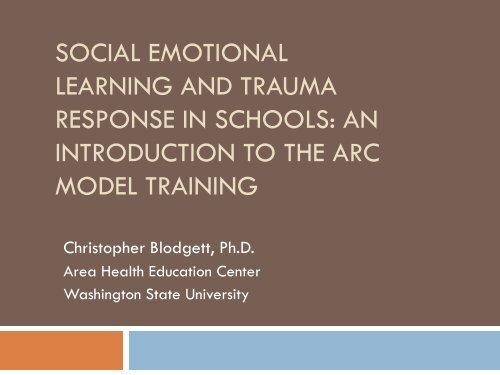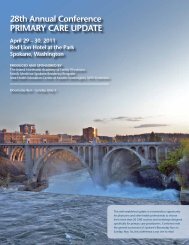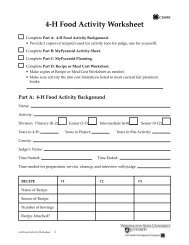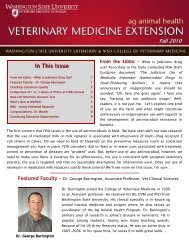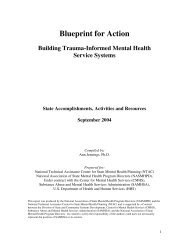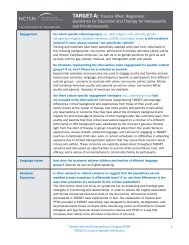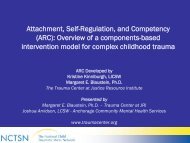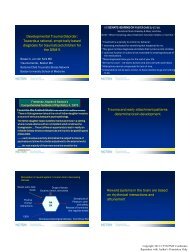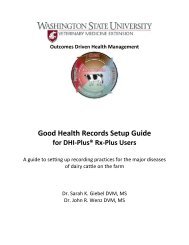Social Emotional Learning and Trauma Response ... - WSU Extension
Social Emotional Learning and Trauma Response ... - WSU Extension
Social Emotional Learning and Trauma Response ... - WSU Extension
Create successful ePaper yourself
Turn your PDF publications into a flip-book with our unique Google optimized e-Paper software.
SOCIAL EMOTIONAL<br />
LEARNING AND TRAUMA<br />
RESPONSE IN SCHOOLS: AN<br />
INTRODUCTION TO THE ARC<br />
MODEL TRAINING<br />
Christopher Blodgett, Ph.D.<br />
Area Health Education Center<br />
Washington State University
Plan for the discussion<br />
<strong>Social</strong> <strong>Emotional</strong> <strong>Learning</strong> in educational practice<br />
Dealing with complex trauma as the missing piece in<br />
successful social emotional learning<br />
Why knowing a little about brain development <strong>and</strong><br />
stress matters<br />
Education as the business of brain development<br />
Introduction to complex trauma<br />
Local research evidence<br />
Risk <strong>and</strong> exposure is not destiny- many reasons for hope<br />
The ARC Model as a common framework for a<br />
continuum of response
You can’t teach if they can’t learn.<br />
“In college I was taught how to teach.<br />
I wasn’t taught how children learn.”<br />
An elementary school teacher introduced to trauma <strong>and</strong> its effects<br />
on students.<br />
Copyright 2010 <strong>WSU</strong> Area Health Education Center
Why P-12 education has a fundamental<br />
stake in addressing trauma<br />
4<br />
<br />
<br />
<br />
<br />
<br />
Schools have to educate all students<br />
An estimated 20 percent of children suffer from a<br />
psychological disorder<br />
Included in this 20%, 7-10% of the general population of<br />
children suffer from Serious <strong>Emotional</strong> Disturbance conditions<br />
Annually only 10-20 percent of SED children receive<br />
specialized mental health services<br />
The service access disparity for younger children is particularly acute.<br />
“Only 1 to 2 percent of preschoolers used any services; the average rates<br />
increased in older children—6 to 8 percent of children ages 6 to 11, <strong>and</strong> 8 to 9<br />
percent of adolescents ages 12 to 17.” (National Workgroup, 2001; p 34).<br />
Schools are the principal provider of mental health services to<br />
children in the United States<br />
Copyright <strong>WSU</strong> AHEC 2010
Why this is relevant to you as<br />
5<br />
educational leaders<br />
Children’s behavior <strong>and</strong> emotional adjustment<br />
facilitates or hinders their own academic success.<br />
What children bring to school not only challenges<br />
their own learning but also create burden for<br />
schools as systems because their behaviors affect<br />
other students <strong>and</strong> teachers.<br />
How classroom teachers succeed with traumatized<br />
children’s needs is foundational to the success of all<br />
children in the class
5 proposals for consideration<br />
1. Relationship is the evidence-based<br />
practice.<br />
2. How we feel defines how we learn.<br />
3. <strong>Social</strong> emotional learning is an essential<br />
condition for academic success.<br />
4. <strong>Trauma</strong> is what places learning at risk.<br />
5. <strong>Trauma</strong> is an existential threat to schools.<br />
Copyright <strong>WSU</strong> AHEC, 2010
7<br />
Still Face Experiment <strong>and</strong> Relationship<br />
as the Foundation for Development<br />
http://www.youtube.com/watch?v=apzXGEbZht0
9<br />
Complex trauma as new framework for<br />
underst<strong>and</strong>ing a continuum of risk<br />
Both the process of exposure <strong>and</strong> the process of adjustment to<br />
terrible stress<br />
As a common defining concern, complex trauma originates in the<br />
child’s family<br />
But, community violence, racism, <strong>and</strong> the profound stressors of<br />
poverty also contribute to the complexity of trauma<br />
Often occurs early in the child’s life<br />
Occurs at most rapid period of development<br />
Occurs when thought <strong>and</strong> action by the child aren’t options<br />
<strong>Trauma</strong> effects the basic biology of responding to stress<br />
The experience of traumatic events often involves chronic exposure<br />
to trauma<br />
Exposure to multiple trauma types is common.<br />
Exposure to one trauma type is a marker for risk of exposure to<br />
others<br />
<br />
<br />
<br />
<br />
Copyright <strong>WSU</strong> AHEC 2010
10<br />
Complex <strong>Trauma</strong> is<br />
Intimate <strong>Trauma</strong><br />
<br />
<br />
<br />
Involves a range of acts resulting in physical trauma,<br />
psychological trauma, <strong>and</strong> the disruption of basic conditions<br />
of health <strong>and</strong> wellbeing.<br />
Persists over time.<br />
◦ While intimate trauma exposure may be limited to a single or shortterm<br />
set of events, this is the exception.<br />
<strong>Trauma</strong> exposure is typically persistent but episodic.<br />
◦ The victim endures high levels of unpredictability <strong>and</strong> recurrent<br />
exposure to risk.<br />
◦ Disruption of the quality <strong>and</strong> consistency of the intimate environment<br />
which supports development<br />
<strong>WSU</strong> Area Health Education Center Copyright 2008
Principal trauma behavior domains<br />
11<br />
Attachment<br />
<strong>Social</strong> emotional development<br />
Self-concept<br />
<strong>Emotional</strong> regulation<br />
Impulse control <strong>and</strong> aggression<br />
Cognition <strong>and</strong> language<br />
<strong>WSU</strong> Area Health Education Center Copyright 2008
<strong>Social</strong> emotional development<br />
12<br />
Developmental dimensions to social emotional<br />
mastery<br />
Awareness <strong>and</strong> use of emotions in relationships<br />
Unfolding of social communication<br />
Valuing of intimate connections<br />
Progressive autonomy <strong>and</strong> initiative without sacrificing connection<br />
Capacity to negotiate relationships with empathy, compassion, <strong>and</strong><br />
respect<br />
Sense of self-efficacy<br />
<strong>Trauma</strong> impacts<br />
Developmentally immature behavior<br />
Failure to master key domains effectively<br />
<strong>WSU</strong> Area Health Education Center Copyright 2008
Self concept <strong>and</strong> trauma<br />
13<br />
Feel incapable of having a positive impact on the<br />
outside world<br />
Hopelessness<br />
Difficulty in initiating play or having safety with<br />
imagination <strong>and</strong> exploration<br />
Low self-esteem--diminished sense of self worth<br />
Disturbances of body image<br />
Shame <strong>and</strong> guilt; self blame<br />
Unsure of own needs <strong>and</strong> often lack capacity to get<br />
needs met<br />
<strong>WSU</strong> Area Health Education Center Copyright 2008
14<br />
<strong>Emotional</strong> regulation<br />
Emotions organize thought <strong>and</strong> prepare our bodies<br />
for action<br />
Relationship is first built in reading <strong>and</strong> interpreting<br />
emotions<br />
Well-being involves accurately reading our internal<br />
emotional state <strong>and</strong> accurately perceiving the<br />
emotions of others<br />
Mastery involves impulse control in service of<br />
planning<br />
Empathy critical to planning <strong>and</strong> creation of range<br />
of responses<br />
<strong>WSU</strong> Area Health Education Center Copyright 2008
<strong>Emotional</strong> regulation <strong>and</strong> trauma<br />
15<br />
<strong>Trauma</strong> impairs emotional learning.<br />
<strong>Trauma</strong> constricts the range of feelings <strong>and</strong><br />
behaviors options we have in managing<br />
ourselves <strong>and</strong> our relationships with others.<br />
Survival trumps exploration <strong>and</strong> growth<br />
Dysregulation<br />
Dissociation, numbing, <strong>and</strong> withdrawal<br />
<strong>WSU</strong> Area Health Education Center Copyright 2008
Cognitive Development<br />
16<br />
Progressive development through young adulthood<br />
from concrete to abstract thought<br />
◦ Executive function- ability to plan, anticipate, value, <strong>and</strong> be<br />
goal-directed in behavior<br />
Progressive ability to use imagination in planning<br />
Progressive ability to use language to create<br />
meaning (expressive <strong>and</strong> receptive language)<br />
Progressive integration of a moral sense into<br />
reasoning <strong>and</strong> choice<br />
Progressive capacity to sustain attention in organizing<br />
behavior<br />
<strong>WSU</strong> Area Health Education Center Copyright 2008
How Complex <strong>Trauma</strong> Can/May Disrupt<br />
Cognition:<br />
<br />
<br />
<br />
<br />
<br />
Difficulty in their ability to<br />
learn <strong>and</strong> process verbal<br />
information<br />
Harder to use language as<br />
a vehicle for communication<br />
Difficulty in organizing <strong>and</strong><br />
remembering new<br />
information<br />
Difficulty underst<strong>and</strong>ing<br />
cause <strong>and</strong> effect<br />
Tend to have poor problem<br />
solving skills<br />
<br />
<br />
<br />
<br />
Difficulty focusing on<br />
tasks at h<strong>and</strong><br />
Difficulty planning <strong>and</strong><br />
anticipating<br />
Problems with orientation<br />
in time <strong>and</strong> space<br />
Difficulty focusing on <strong>and</strong><br />
completing tasks<br />
17<br />
<strong>WSU</strong> Area Health Education Center Copyright 2008
How trauma may change how students<br />
succeed in classrooms<br />
<strong>Trauma</strong> leads children to appraise many situations as<br />
threats<br />
Limited age-appropriate negotiation skills<br />
Relate through their biological reactions<br />
Not as open to realistic appraisal of the situation <strong>and</strong> to new<br />
learning<br />
Their interpretations do not fit our expectations <strong>and</strong> our lack<br />
of underst<strong>and</strong>ing results in us misperceiving the purpose <strong>and</strong><br />
meaning of the child’s behavior<br />
They act inappropriately <strong>and</strong> violate our own sense of<br />
comfort, safety, <strong>and</strong> expectations<br />
• Triggers for rejection, isolation, re-traumatizing actions<br />
• You can’t teach or care effectively when you are angry<br />
Copyright 2010 <strong>WSU</strong> Area Health Education Center
Copyright 2010 <strong>WSU</strong> Area Health Education Center
Adult research on trauma impact<br />
20<br />
The Adverse Childhood Experiences (ACE) Study<br />
A decade-long, ongoing study conducted collaboratively with the<br />
Centers for Disease Control (CDC) <strong>and</strong> the Kaiser Health Plan.<br />
17,000 members of the Kaiser Permanente Medical Care<br />
Program in San Diego.<br />
Self-report tied to medical records.<br />
Stressful or traumatic childhood experiences are a<br />
common pathway to social, emotional, <strong>and</strong> cognitive<br />
impairments<br />
These trauma experiences are predictive of increased risk<br />
of disease, physical <strong>and</strong> mental disability, social<br />
problems, <strong>and</strong> premature mortality<br />
Copyright <strong>WSU</strong> AHEC 2010
21<br />
ACE predict long term health <strong>and</strong> social<br />
outcomes<br />
<br />
<br />
ACE exposure<br />
With four or more categories<br />
of childhood exposure,<br />
compared to adults with no<br />
ACEs<br />
4 to 12-fold increased<br />
alcoholism, drug abuse,<br />
depression, <strong>and</strong> suicide attempt<br />
2 to 4-fold increase in poor<br />
self-rated health<br />
3 to 4-fold increase in chronic<br />
illness (heart disease, liver<br />
disease)<br />
(ACE<br />
Score)<br />
Women<br />
%<br />
Men<br />
%<br />
Total<br />
%<br />
0 34.5 38 36.1<br />
1 24.5 27.9 26<br />
2 15.5 16.4 15.9<br />
3 10.3 8.6 9.5<br />
4 or<br />
more 15.2 9.2 12.5<br />
Copyright <strong>WSU</strong> AHEC 2010
Relationship is the<br />
evidence-based practice.<br />
‘Placebo’ as a powerful intervention<br />
The real <strong>and</strong> meaningful value-added of specific<br />
curricula <strong>and</strong> interventions as EBPs<br />
The universal benefits of<br />
Positive regard<br />
Genuineness<br />
Warmth<br />
Positive reinforcement<br />
Attachment as foundational to all we do<br />
Copyright <strong>WSU</strong> AHEC, 2010
How we feel defines how we learn.<br />
Neurodevelopment has to guide how we teach <strong>and</strong> how<br />
we support children.<br />
Recalibrating our expectations of children based on<br />
knowledge of neurodevelopment.<br />
<strong>Trauma</strong> can interfere with maturation<br />
Under stress, we respond from more basic areas of the<br />
brain<br />
<strong>Social</strong> emotional development <strong>and</strong> learning is the<br />
smooth integration of feelings <strong>and</strong> thought.<br />
<strong>Trauma</strong> challenges this smooth integration by disrupting<br />
what has been learned <strong>and</strong> compromising new learning.<br />
Copyright <strong>WSU</strong> AHEC, 2010
Key Principles of Brain Function<br />
Principle 1: Brain function is hierarchical. Our first<br />
responses are based in non-conscious, reflexive, <strong>and</strong><br />
conditioned responses.<br />
Principle 2: The brain develops in a sequential fashion.<br />
Principle 3: The brain develops most rapidly early in life.<br />
Principle 4: Brain systems change with use throughout life.<br />
Principle 5: Our brains are designed to benefit from rich<br />
<strong>and</strong> supportive intimate social relationships.<br />
Principle 6: We feel <strong>and</strong> then we think.<br />
Principle 7: Neural systems can be changed, but some<br />
systems are easier to change than others.<br />
Principle 8: Stress can change brain development.<br />
Adapted from Perry (2006)<br />
Copyright 2010 <strong>WSU</strong> Area Health Education Center
25<br />
<strong>Trauma</strong>’s potential pathways of influence<br />
on brain development 1<br />
1. Access to adequate stimulation at key times that<br />
organizes brain structure <strong>and</strong> function<br />
2. Elevated stress hormone levels (particularly adrenaline<br />
<strong>and</strong> cortisol) may impact brain structural development<br />
<br />
<br />
Sustained stress hormones correlated with reductions in brain<br />
development <strong>and</strong> function<br />
Memory, emotional regulation, <strong>and</strong> stress regulation<br />
<br />
Verbal skills, memory, <strong>and</strong> problem solving<br />
<br />
Focus for new learning <strong>and</strong> modification through teaching<br />
Copyright 2010 <strong>WSU</strong> Area Health Education Center
Nervous system development <strong>and</strong><br />
specialization- What stress can interrupt<br />
De Bellis, 2005<br />
Copyright 2010 <strong>WSU</strong> Area Health Education Center
The Threat-Arousal System <strong>Response</strong> Continuum<br />
Adapted from Dr. Bruce Perry<br />
Perceived<br />
Threat<br />
Level<br />
Low<br />
High<br />
Adaptive<br />
<strong>Response</strong><br />
Regulating<br />
Brain<br />
Region<br />
Receptive<br />
Ready to<br />
Learn<br />
Cortex<br />
Vigilance<br />
Cortex/<br />
Limbic<br />
Freeze/<br />
Withdrawal<br />
Limbic/<br />
Midbrain<br />
Midbrain/<br />
Brain<br />
Stem<br />
Flight/<br />
Fight<br />
Brain<br />
Stem<br />
Cognition Abstract Concrete <strong>Emotional</strong> Reactive Reflexive<br />
Physical<br />
State<br />
Calm<br />
Arousal/<br />
Attention<br />
Alarm Fear Terror<br />
Copyright 2010 <strong>WSU</strong> Area Health<br />
Education Center
28<br />
<strong>Trauma</strong>’s potential pathways of influence<br />
on brain development 2<br />
3. Immaturity of the threat-arousal management system<br />
<br />
<br />
<br />
<br />
<br />
<br />
<strong>Trauma</strong> responses primarily regulated by biological<br />
systems beneath language <strong>and</strong> reasoning<br />
What defines threat becomes disordered<br />
• Not having learned to be safe makes most situations unsafe<br />
Brain development follows use- risk of the dominating<br />
use of more primitive responses<br />
Survival trumps new learning<br />
Smooth integration of reasoning, emotional response,<br />
<strong>and</strong> basic biological response to threat compromised<br />
Threat-arousal can be managed in our relationships<br />
Copyright 2010 <strong>WSU</strong> Area Health Education Center
Implications of impaired threat-arousal response<br />
We need to calibrate our relationship <strong>and</strong> goals to<br />
the arousal level of the child<br />
New learning can not occur effectively in high states of<br />
painful arousal<br />
<strong>Response</strong> options available to children reflect their<br />
level of present arousal <strong>and</strong> their range of skills <strong>and</strong><br />
learning<br />
Arousal level can be re-regulated to permit students<br />
to access higher levels of thought <strong>and</strong> new learning<br />
Don’t personalize the trauma response<br />
Copyright 2010 <strong>WSU</strong> Area Health Education Center
How we manage stress is<br />
how we manage learning<br />
<br />
<br />
<br />
<br />
<br />
Brain <strong>and</strong> hormonal systems are a single unified system<br />
Central nervous system appraisal of threat <strong>and</strong> triggering<br />
of threat response<br />
Direct neural <strong>and</strong> hormonal responses to prepare fight/flight<br />
survival responses<br />
Conscious thought is where we may get but it is not where<br />
we start.<br />
Reasoning follows emotion<br />
How well we integrate emotion <strong>and</strong> thought predicts how flexibly<br />
we adjust <strong>and</strong> learn.<br />
If we manage our stress, we manage our potential to learn.<br />
As adults, we often misinterpret threat reactions as<br />
intentional challenges to us. We are usually wrong.<br />
Copyright 2010 <strong>WSU</strong> Area Health Education Center
<strong>Trauma</strong>, Teaching, <strong>and</strong> <strong>Social</strong> <strong>Emotional</strong> <strong>Response</strong><br />
<br />
<br />
Students<br />
Poor skills in managing relationships<br />
May misinterpret behavior because of hyper-vigilance <strong>and</strong><br />
misperception of engagement as threat.<br />
<strong>Trauma</strong>tized children’s impulsive behaviors, poor affective<br />
management (including withdrawal <strong>and</strong> aggression), <strong>and</strong> poor<br />
social skills challenge the teacher’s intention to help <strong>and</strong> support.<br />
Teachers<br />
Teachers’ emotions <strong>and</strong> beliefs define expectations of <strong>and</strong><br />
engagement with students.<br />
Critical to setting the conditions for success.<br />
Teachers engage traumatized children through the lens of their<br />
own trauma histories.<br />
Dealing with trauma can change us.<br />
Copyright 2010 <strong>WSU</strong> Area Health Education Center
Relationship is the evidence-based<br />
practice.<br />
Effective relationships manage stress responses.<br />
‘Placebo’ as a powerful intervention<br />
The real <strong>and</strong> meaningful value-added of specific<br />
curricula <strong>and</strong> interventions as EBPs<br />
The universal benefits of<br />
Positive regard<br />
Genuineness<br />
Warmth<br />
Positive reinforcement<br />
Attachment as foundational to all we do<br />
Copyright <strong>WSU</strong> AHEC, 2010
<strong>Social</strong> emotional learning is an essential condition for<br />
academic success.<br />
Several hundred well-designed studies<br />
Practical, reliable gains with SEL interventions<br />
Reduced behavioral concerns in schools<br />
Improved adjustment in key stress symptoms<br />
Increased school connectedness<br />
Increased academic performance<br />
Tested curricula aligned to routine academic practice<br />
Quality of SEL implementation matters<br />
Teachers have to be the leads.<br />
SAFE- Sequenced, Active, Focused, Explicit skill<br />
development<br />
Copyright <strong>WSU</strong> AHEC, 2010
<strong>Social</strong> emotional learning aligns with effective<br />
classroom management- trauma challenges application<br />
<br />
<br />
<br />
<br />
<br />
<br />
<br />
Clear <strong>and</strong> effective rules <strong>and</strong> procedures<br />
Effective discipline <strong>and</strong> accountability practices support<br />
learning<br />
Role appropriate high quality teacher-student relationships<br />
Teachers’ ‘Mindfulness’ in assessing, anticipating, <strong>and</strong> acting to<br />
support learning <strong>and</strong> behavior<br />
Instruction <strong>and</strong> management practices that support student<br />
responsibility for learning<br />
Parent engagement <strong>and</strong> inclusion in learning supports<br />
Intentional use of physical <strong>and</strong> social environment to support<br />
learning.<br />
Copyright <strong>WSU</strong> AHEC, 2010
<strong>Social</strong> <strong>Emotional</strong> <strong>Learning</strong>’s Key<br />
Domains 1<br />
Self-Awareness: Knowing what we are feeling in the<br />
moment<br />
Having a realistic assessment of our own abilities <strong>and</strong> a wellgrounded<br />
sense of self confidence<br />
<strong>Social</strong> Awareness: Reading what others are feeling<br />
Being able to take their perspective; appreciating <strong>and</strong><br />
Interacting positively with a range of people<br />
Self-Management: H<strong>and</strong>ling our emotions so they<br />
facilitate rather than interfere with the task at h<strong>and</strong><br />
Being conscientious <strong>and</strong> delaying gratification to pursue goals<br />
Persevering in the face of setbacks <strong>and</strong> frustrations
<strong>Social</strong> <strong>Emotional</strong> <strong>Learning</strong>’s Key<br />
Domains 2<br />
<br />
<br />
Relationship Skills: H<strong>and</strong>ling emotions in relationships<br />
effectively<br />
Establishing <strong>and</strong> maintaining healthy relationships based on<br />
cooperation<br />
Resistance to inappropriate social pressure<br />
Negotiating solutions to conflict<br />
Seeking help when needed<br />
Responsible Decision-Making<br />
Accurately assessing risks<br />
Making decisions based on a consideration of all relevant factors <strong>and</strong><br />
the likely consequences of alternative courses of action<br />
Respecting others (empathy)<br />
Taking personal responsibility for one’s decisions
37<br />
Spokane ACEs <strong>and</strong> School Success<br />
Study Summary<br />
• De-identified data collection<br />
• 10 elementary buildings in four districts (5 Title I)<br />
• Students in Grades K-6<br />
• Reviews of 2,101 r<strong>and</strong>omly selected students<br />
• Teachers reported factually what they knew about ACEs<br />
exposure, academic challenges, <strong>and</strong> chronic health concerns.<br />
Suspicions were not reported.<br />
• Academic problems were:<br />
– Failing to meet grade expectations in one or more core subjects<br />
– Attendance problems severe enough to interfere with academic success<br />
– School behaviors severe enough to interfere with academic success<br />
Copyright <strong>WSU</strong> AHEC 2010
Half of the children already are<br />
38<br />
struggling to succeed in school<br />
Specific Concerns<br />
Academic failure- 35%<br />
Serious attendance problems- 13%<br />
Serious behavior concerns- 27%<br />
Combination of Concerns<br />
None 52%<br />
One 26%<br />
Two 17%<br />
Three 5%<br />
Copyright <strong>WSU</strong> AHEC 2010
ACEs Exposure<br />
39<br />
Lifetime Past 12 months<br />
Parents Divorced/Separated 36% 6%<br />
Residential Instability 9% 6%<br />
Domestic Violence Witness 9% 5%<br />
CPS Involved 9% 4%<br />
Jailed Family Member 9% 4%<br />
Substance Abuse in Family Member 7% 3%<br />
Basic Needs 7% 4%<br />
Mental Health Disorder in Family Member 5% 3%<br />
Physical Disability in Family Member 3% 1%<br />
Community Violence Exposure 3% 1%<br />
Parent/Caregiver Death 2% 1%<br />
Copyright <strong>WSU</strong> AHEC 2010
Complex <strong>Trauma</strong> Risk<br />
40<br />
Lifetime<br />
ACE Exposure<br />
Past 12 Month<br />
ACE Exposure<br />
None<br />
One<br />
Two<br />
Three<br />
Four<br />
Five<br />
More than Five<br />
55% 81%<br />
22% 12%<br />
10% 4%<br />
5% 2%<br />
3% 1%<br />
2% 0%<br />
1% 0%<br />
Copyright <strong>WSU</strong> AHEC 2010
ACEs Exposure <strong>and</strong> Student<br />
41<br />
Characteristics<br />
ACE exposure is significantly related to:<br />
Poverty (FRM status)<br />
Race Ethnicity<br />
Special Education enrollment<br />
As a result, the level of exposure to ACEs for<br />
school’s students reflects the students enrolled<br />
Copyright <strong>WSU</strong> AHEC 2010
42<br />
Odds Ratios for Problems with<br />
Increasing ACEs<br />
Academic<br />
Failure<br />
Severe<br />
Attendance<br />
Problems<br />
Severe<br />
School<br />
Behavior<br />
Concerns<br />
Frequent<br />
Reported<br />
Poor<br />
Health<br />
Three or More 2.9 4.9 6.1 3.9<br />
ACEs<br />
Two ACEs 2.5 2.6 4.3 2.4<br />
One ACE 1.5 2.2 2.4 2.3<br />
No Known<br />
ACEs<br />
1.0 1.0 1.0 1.0<br />
Copyright <strong>WSU</strong> AHEC 2010
Percent of Students with One or More Academic Concerns by ACE<br />
Exposure<br />
100%<br />
90%<br />
80%<br />
Percent of Students with Academic Problems<br />
70%<br />
60%<br />
50%<br />
40%<br />
30%<br />
20%<br />
10%<br />
0%<br />
No Known Adverse Events<br />
One Reported Adverse<br />
Event<br />
Two Reported Adverse<br />
Events<br />
Three or more Adverse<br />
Events<br />
One or More Academic Concerns 34% 56% 71% 80%<br />
43<br />
Copyright <strong>WSU</strong> AHEC 2010
Summary on risk in schools<br />
44<br />
One in five children in Spokane exposed to multiple<br />
ACEs<br />
An estimated 15,000 students in Spokane County K-12<br />
ACE exposure has a dose effect in young children<br />
where exposure directly predicts developmental<br />
risk <strong>and</strong> poor health experiences<br />
ACE exposure is the most powerful predictor of<br />
childhood risk among the student characteristics<br />
examined with the exception of SPED<br />
Copyright <strong>WSU</strong> AHEC 2010
What schools can do to change the impact<br />
of trauma<br />
Six basic goals to guide school improvement strategies<br />
1. Build meaningful relationships<br />
• Preparation to learn <strong>and</strong> grow<br />
• Engagement to parents where <strong>and</strong> when possible <strong>and</strong> safe<br />
2. Create safety <strong>and</strong> predictability<br />
3. Promote skill development from where students are<br />
• Accountability as an essential survival skill<br />
4. Meaning-making (reasoning <strong>and</strong> problem-solving)<br />
5. Enhance resiliency<br />
6. Add targeted supports when support is needed<br />
Copyright 2010 <strong>WSU</strong> Area Health Education Center
46<br />
A framework for trauma-sensitive<br />
school response<br />
<strong>Response</strong> to Intervention as planning framework<br />
integrate social emotional learning in curriculum<br />
Reduce triggers of trauma responses<br />
Professional development in social emotional learning <strong>and</strong> traumainformed<br />
practice<br />
Classroom management <strong>and</strong> building teams<br />
Effective assessment <strong>and</strong> management of risk<br />
Targeted use of brief, effective interventions<br />
Integration of care planning with building classroom success<br />
More sustained remedial care where needed<br />
Coordination of care <strong>and</strong> supports in the community when<br />
possible
What ARC Can Offer<br />
A common vocabulary for responses from<br />
classrooms to individualized services<br />
Having intervention concepts aligned with our universal<br />
education goals<br />
Linking social emotional growth with trauma recovery<br />
Adapting trauma knowledge <strong>and</strong> language into<br />
classroom management<br />
A specific intervention that can be delivered in school<br />
settings


